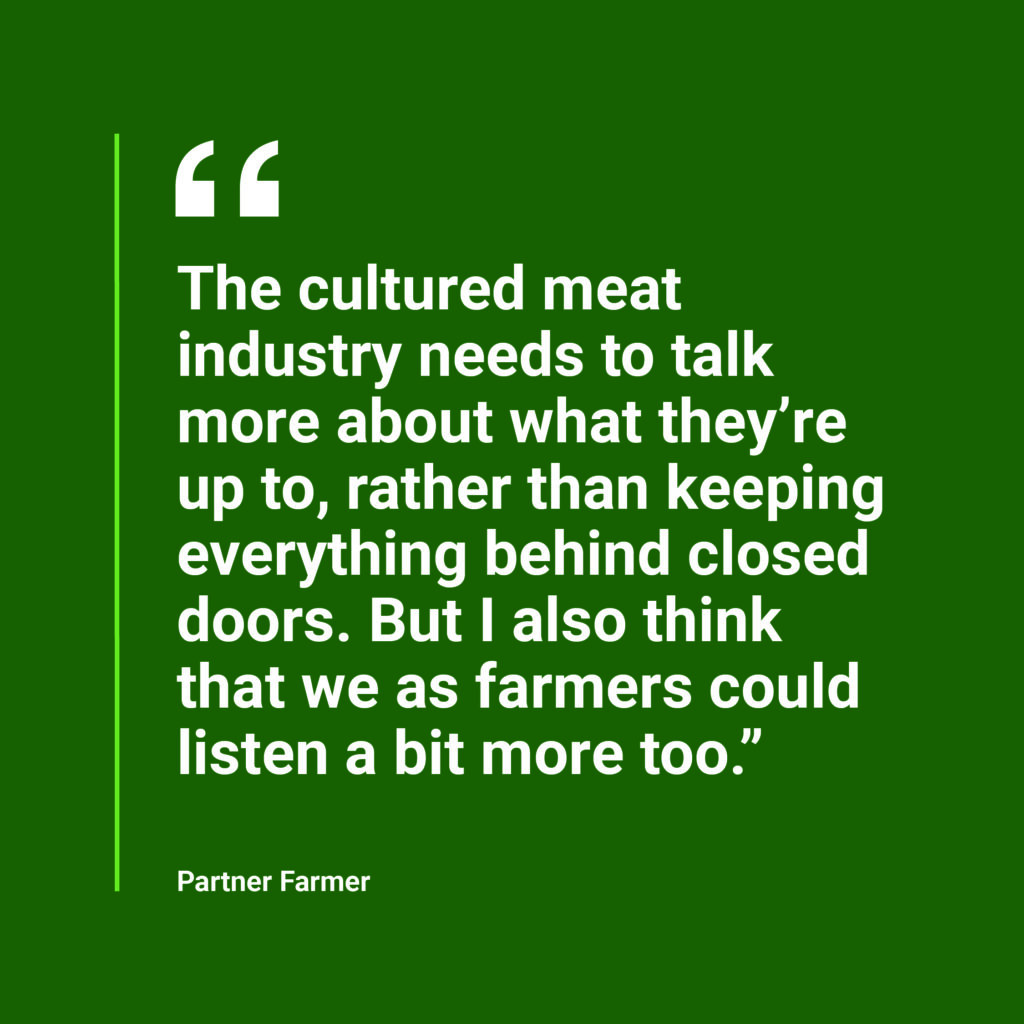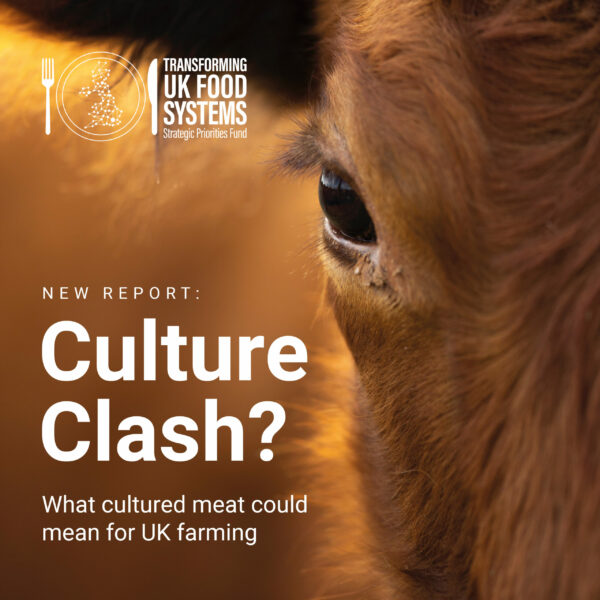In 2022, UK Research and Innovation funded one of the first interdisciplinary projects to examine the potential impacts of cultured meat on farming businesses. The team and partners included natural and social scientists, farming representatives, cultured meat businesses, NGOs and policymakers. New Harvest was thrilled to be part of the Advisory Board and participate in some outreach to farmers.
Over the two years of the project, the research team analyzed social media, conducted focus groups with 80 farmers to discuss perceptions of cultured meat, collaborated with nine varied UK farm businesses to understand the potential impacts of cultured meat on farming livelihoods, and explored innovative methods where farmers can be involved in cultured meat production.
Why this project was important
Cultured meat is often portrayed as a competitor to traditional farming; however, we need to acknowledge the technology remains in its infancy. Its current commercial production is minimal and unlikely to significantly disrupt the existing food system or provide the benefits its supporters claimed in the short-term.
This project shed light on what farmers care about, worry about, and see as an opportunity to improve their business. It exemplified how proactively implementing some short-term actions can foster relations between traditional farming and cultured meat, optimizing the benefits of both food production methods to enhance our food system.

Key Takeaways
- Nuanced Perspectives: The discussion surrounding cultured meat is often polarized. While recent messaging has shifted towards inclusivity and collaboration, the early and still prevailing narrative of “decoupling animal farming from our food supply”—frequently echoed in social media and news—may lead policymakers to adopt extreme positions. It is essential to recognize that many farmers are actively working to enhance their practices for more sustainable food systems. Ultimately, cultured meat is just one of the many tools becoming available.
- Concerns of Farmers: During the discussions, farmers expressed their concerns, which fell into six categories:
- Uncertainty: The diverse range of cultured meat products targeting various markets (e.g., ground meat, hybrids, gourmet, steaks) leaves farmers needing clarification about the technology’s potential impact on their operations.
- Unreliable: There is a lack of transparency, as companies do not share sufficient technical information and data about their processes.
- Unrealistic: The cultured meat discourse has limited conversations about supply chains, dietary effects, and land use. Farmers are keen to bring these topics up to ensure fair comparisons with cultured meat.
- Unintended Consequences: Farmers are concerned about the potential impacts of cultured meat on the complex farming ecosystem and the side effects of replacing conventional meat production.
- Unfair Dynamics: Some farmers worry that cultured meat could exacerbate power consolidation within the food sector rather than serve as a genuine “game changer.”
- Naturalness Debate: Some farmers raised questions about the “naturalness” of cultured meat compared to conventional meat.
- Farmers are grappling with other immediate challenges that are more pressing than the potential effects of cultured meat. However, they have demonstrated resilience and adaptability. They require a clear understanding of the advantages and disadvantages of cultured meat to evaluate its potential opportunities. Illiquidity, contractual obligations, intermediaries, succession issues, and debt can heighten their vulnerability to changes and disruptions. Those interviewed indicated they do not envision abandoning farming altogether. For many involved in agriculture, farming transcends mere food production; it embodies a lifestyle and identity.
- Cell ag enthusiasts have promoted the vision of establishing cultured meat production facilities on farms; however, there are several factors that can influence this vision, including the associated costs that may be prohibitive for farmers unless significant reductions in capital costs are achieved.
- The project team identified three opportunities for fostering collaboration between cultured meat and traditional farming:
- Research Collaboration: Explore joint research initiatives that seek utilizing agricultural by-products as inputs for cultured meat production. While canola meal has been a common focus of research, other by-products such as hoof and horn meal and bovine blood could also be potential amino acid sources.
- Farmer Engagement: Enhance farmer engagement through neutral platforms and resources developed in partnership with cultured meat specialists and farmers. Many farmers seemed to be eager to learn more about cultured meat.
- Corporate Commitment: Encourage cultured meat companies to adhere to Environmental, Social, and Governance (ESG) frameworks, with investors playing a crucial role in promoting these commitments.

What could follow up
“The Cultured Meat and Farmers” project establishes an initial understanding of the complexity of the UK farming sector and the potential risks and opportunities that emerging cultured meat production technologies might present. Early communication between farmers and those working in cultured meat is important to help mitigate unnecessary tensions and foster potential partnerships. To that end, this initiative has paved the way for ongoing dialogue, which could be expanded using the same model to include other stakeholders within the UK agricultural value chain.
By conducting similar research across different countries, and sharing findings with the broader community, we can gain valuable insights that benefit all stakeholders, including industry and policymakers. After all, it is essential to capture regional nuances in such studies. New Harvest is helping lead projects within the EU and Canada that involve engagement with farmers as part of their research. In the EU, FEASTS considers the potential socio-economic impacts of cultured meat in specific. While in Canada, we’re working on a Prairies-wide project that will bridge the gap between crop producers and the cell ag sector to assess the feasibility of developing supply chains for cell ag. Both projects have much to gain from, and share with, UK projects like the UKRI study.
Also, given similarities with cultured meat, we believe it would be beneficial to replicate this approach for precision fermentation technologies, particularly in the realm of dairy alternatives.
Ultimately, the future of food production will be greatly enhanced through collaboration, ensuring that the needs and identities of farmers are respected alongside the advancements offered by new technologies.




